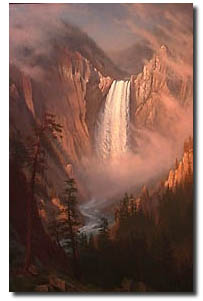%20of%20historybar.JPG)
The
Corp of Discovery led by Lewis and Clark were the 
first whites to explore the greater Yellowstone region among them was
one of the most celebrated hunter and woodsman of that period, John
Colter. On the return of the expedition in 1908, Colter returned to
the Yellowstone and trap this region and in doing so became the first
white visitor to what is now Yellowstone National Park. Upon his
return, his "tales" were so unbelievable that no author or
mapmaker would publish it for fear of scrutiny amongst their piers.
Colters stories about the wonders and
wildlife, led the fur traders to explore the Yellowstone regions. Most
of the mountain men during that era were experienced in trapping and
survival, they were also illiterate. Fortunately, Osborn Russell
was unique, he knew how to trap, read and write and his journals are
the earliest accounts of the Yellowstone region.
"There is something in the
wild scenery of this valley which I cannot describe: but the impressions
made upon my mind while gazing from a high eminence on the surrounding
landscape one evening as the sun was gently gliding behind the
western mountain and casting its gigantic shadows across the vale
were such as time can never efface. For
my own part I almost wished I could spend the remainder of my
days in a place like this where happiness and contentment seemed
to reign in wild romantic splendor" - Lamar Valley, Osborne Russell 1835
"I sat there in amazement,
while my companions came up, and after that, it seemed to me it
was 5 minutes before anyone spoke. Language is inadequate to convey
a just conception of the grandeur and sublimity of this masterpiece
of nature's handiwork" Artist Point - Charles
Cook 1869 |
In the latter part of 1840 the fur trade
was coming to an end. The trappers who remained in the region adapted
and among them was the distinguished, Jim Bridger. Bridger, a natural
born topographer, new the fur trade was over and became a guide, scout
and legendary story teller. His knowledge of what is now Yellowstone
National Park was unparalleled and he became the first "geographer"
of the region and was summoned to guide Capt. W.F Raynolds including
Dr. Ferdinand Hayden and the Raynold's Expedition of 1859. Due to the
expeditions schedule and uncompromising weather this first organized
exploration of the Yellowstone region was unsuccessful.
"The Essenstials for
Planning your
Trip to Yellowstone Park" |
|
|
|
|
During the 1850's to 1870, miners inhabited
the Yellowstone and in doing so helped to publicize the region however
with not much more credibility than their trapper predecessors. In 1863,
Walter Delacy and his party set out to prospect through the Yellowstone.
Although the party was equipped with prospector tools and no survey
equipment, his party made many new discoveries including Shoshone and
Lewis Lake he also published the first map of the Yellowstone area.
By 1870, gold fever was gone and the great Yellowstone expeditions began.
In 1869, D.E. Folsom, William Peterson
and C.W. Cook completed the first successful privately organized Yellowstone
expedition. After 36 days, they completed their quest and returned back
to Helena, Montana to publish their findings only at first to receive
the same response as John Colter and Jim Bridger, that their story was
too risky. Eventually their exploits were published by the Western Monthly
Magazine of Chicago.
One year after the Folsom-Cook party
reported about the wonders of Yellowstone, Gen. Henry D. Washburn organized
the next expedition into Yellowstone. His party included Nathaniel
P Langford and a military escort led by Gustavus C.Doane. This Party
was responsible in the early place names of Yellowstone National Park's
most historical sites including Old Faithful,Castle Geyser,Giant Geyser
and Grand Canyon of the Yellowstone. This was a successful expedition
in terms of their credibility in verifying and naming early historic
landmarks. The mission was not without hardship when one of the
party members, Truman C. Everts became lost and endured a 37 day ordeal
to finally be rescued by Jack Baronett. Upon the return of the Washburn-Langford-Doane
Expedition, the leaders of the party set out in their own specific ways
by lectures and print (no www.YellowstoneNationlPark.com back then).
During one of Langford's lectures. Dr. Ferdinand Hayden was in attendance.
Hayden proceeded to capitalize on the
current interest in the Yellowstone region by asking Congress for funds
for an official expedition into the Yellowstone region. With influential
friends seated in Congress at that time, it did not take long before
he was granted appropriations for $40,000 for a geographical survey
to investigate the Missouri and Yellowstone territories. Hayden assembled
his dream team including James Stevenson, Albert Peale, William Jackson
and Thomas Moran. The artists and photographer proved to be invaluable
to the expedition for their paintings and photographs served as dramatic
and effective testimonials in favor of establishing the park. Along
with new discoveries and place names the party collected geological,
botanical, zoological specimens, sketches, photographs and countless
volumes of exploration notes. This collection of data was brought before
the public and congress. The bill's chief supporters convinced their
colleagues that the region's real value was as a park area, to be preserved
in its natural state. On March 1, President Grant signed the bill into
law, establishing the Yellowstone region as a public park and setting
a major conservation precedent. The Nation had its first national park;
an area of exceptional beauty was set aside for the enjoyment of generations
to come, and a tradition of preserving similar areas was established.
|

